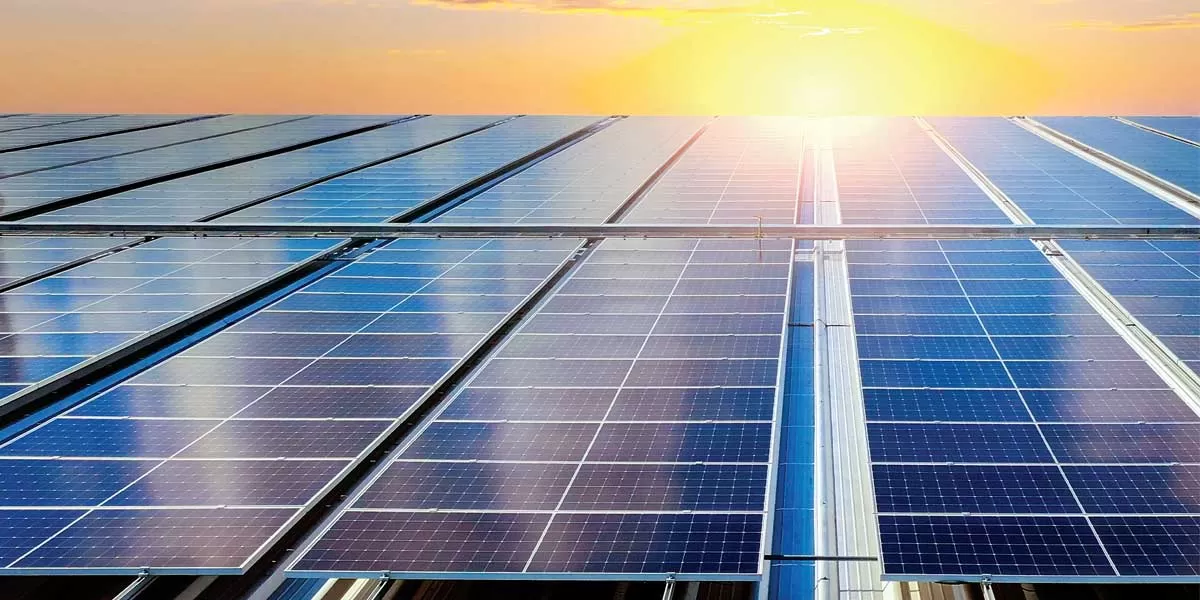A successful transition to new and renewable energy sources by the world’s fastest-growing major economy won’t only serve as a template for other countries but will also help firmly position it as a global green energy hub.
A day after the ambitious Pradhan Mantri Surya Ghar Muft Bijli Yojana or Prime Minister’s free electricity scheme for residential rooftop solar was outlined in the Interim Budget in February, former Union Minister of Power and New and Renewable Energy Raj Kumar Singh was interacting with the media in New Delhi. The straight-talking former bureaucrat told Infrastructure Today. “The [intended] beneficiaries will be identified through surveys of their rooftops. We are initially targeting 10 million beneficiaries. However, the number is likely to go up.” With Prime Minister Narendra Modi-led National Democratic Alliance (NDA) coalition winning a third term in office, Singh’s successor Pralhad Venkatesh Joshi in the MNRE Ministry has to ensure a successful rollout of the world’s biggest transition to green energy sources, which includes the rooftop solar scheme.
Given the ambitious breadth of the scheme seeking to reach subsidised solar power to a large population, sceptics questioned its feasibility and acceptance. However, within a month of the programme launching, more than the targeted number have registered for it, leading PM Modi to post on the microblogging site X, “Registrations have been pouring in from all parts of the nation.” The overwhelming response not only points to the growing consumer aspiration for uninterrupted power supply but also how the transition to new and renewable energy sources has firmly become part of the national discourse in the world’s third-largest energy consumer after China and the US. Under the scheme, the government will provide a 60 per cent subsidy on the solar unit cost for systems up to 2 kilowatts (kW) capacity and 40 per cent for systems between 2 to 3 kW capacity. Central Public Sector Enterprises (CPSEs) active in the power sector will raise bank loans for the rooftop installations of 1kW for poor households through Special Purpose Vehicles (SPVs) set up for the purpose. These SPVs will sell excess electricity produced to the distribution company to realise the loan amount over a ten-years, before handing over the installation to the homeowner.
Tata Power, the country’s largest
integrated power company that leads in the solar rooftop segment, is already eyeing a massive growth opportunity here. “Considering that we already have a market share of nearly 20 per cent, we are looking at something near to that. Mind you that we already have more than 2 GW of rooftop solar installed in the country,” Praveer Sinha, MD & CEO, Tata Power said during an analyst call for 4QFY24. Naveen Munjal, Director of Business Development & Commercial, Apraava Energy asserts that with 10 million rooftops, each adding around 3 kW, solar power would contribute nearly 30-gigawatt (GW) capacity to the grid. This would also create thousands of jobs in installation, panel maintenance, and solar panel and inverter manufacturing. “This significant addition will create opportunities for system providers to integrate this power. The scheme will also enable the government to remove some subsidies causing tariff distortions.”
The increase in subsidy will also help
boost the residential solar rooftop by tackling the cost hurdle. “To provide a context, the
solar rooftop segment reached an installed base of 11.08 GW as of December 2023, of which only 2-3 GW were residential
installations per government disclosures.
The remainder has been driven primarily
by the commercial and industrial segment, which typically has a larger scale plant size and also benefits in terms of energy savings vis-a-vis utility rates,” informs Miren Lodha, Director of Research CRISIL Market Intelligence & Analytics.
Per Infrastructure Today analysis, the PM Surya Ghar Yojana is poised to become the world’s largest rollout of residential rooftop solar within two years. With 1.1 kW for each citizen, currently, Australia tops the list of countries with per capita rooftop photovoltaic (PV) installations. The Kangaroo Country has more than 20 GW of small-scale rooftop solar capacity installed by households and businesses, according to a 2023 study.
Ensuring energy security
With India having displaced China in population, laying a firm foundation for the country’s energy security is required to meet the prerequisite of rapid urbanisation, expansion of transportation infrastructure, increase in industrial production, and growth in electricity consumption in the coming decades. The uncertainty caused by the ongoing geopolitical realignments, fuel price volatility, and collapse of traditional supply chains has fast-tracked the process. The world’s fifth-largest economy, imports over 87 per cent
of its oil and nearly 50 per cent of its
gas requirements.
At the same time, the country has set an ambitious target of achieving net zero emissions by 2070 by meeting 50 per cent of its electricity requirements through renewable energy, the highest among G20 economies. The country has reported significant progress in this direction. By November 2021, it had successfully installed 156.83 GW of green energy, or over 40 per cent of the target capacity (390.8 GW) of 2030, a full nine years ahead of schedule. Singh is confident of breaching the revised projection of 65 per cent by 2030.
So far, the country appears to be on the right track, exhibiting one of the fastest transitions to renewable energy. From launching the International Solar Alliance (ISA) in 2015 to the National Green Hydrogen Mission in 2023 to the PM Surya Ghar Muft Bijli Yojana in 2024, it has already achieved several notable milestones. “We have witnessed significant strides in capacity addition and a robust bidding system that’s attracting investment. This is a positive indicator of the country’s commitment to clean energy,” avers Kannan Krishnan, Joint Managing Director, Jakson Green.
Brajesh Singh, India President, Arthur D Little (ADL) feels the progress has been phenomenal and needs to be emulated by other countries. “India has made conscious efforts to boost the installation of solar rooftops for domestic prosumers in India, and it is important to highlight that more than 3 GW is already installed. There are PLI (Production Linked Incentive) and various schemes to address the affordability and access of rooftop solar.” The country’s ambitious renewable energy targets are already acting as a catalyst for the transformation of its power sector, according to International Energy Agency (IEA) data. It is equally critical to put the industrial sector on the same path, through more widespread electrification, material and energy efficiency, technologies such as Carbon Capture, Utilisation and Storage (CCUS), and a gradual shift to lower-carbon fuels, recommends IEA. The country has also been trying to reduce the storage cost of renewable energy. In February 2024, the Solar Energy Corporation of India, a CPSE under MNRE, commissioned the country’s largest Battery Energy Storage System (BESS) in Rajnandgaon (Chattisgarh). The facility has an installed capacity of 152.325-megawatt hour (MWh) and a despatchable capacity of 100 MW Alternating Current (AC).
Under the National Green Hydrogen Mission, Brajesh Singh forecasts India’s emergence as the commodity’s leading supplier, with production capacity increasing from 5 million metric tonnes (MMT) to 10 MMT by 2030. He is confident of meeting this target as policies such as free transmission, open access and non-applicability of cross-subsidy surcharges on renewable energy required for making green hydrogen are already in place. The EU member states, Japan and South Korea have evinced interest in sourcing green hydrogen and green ammonia supplies from the country. Green hydrogen and other low-carbon technologies can potentially create an $80-billion market in India by 2030, says IEA. The Ministry of Petroleum and Natural Gas has asked oil marketing companies Indian Oil Corporation, Hindustan Petroleum Corporation, and Bharat Petroleum Corporation to start preparations for a switchover to green hydrogen from grey hydrogen for hydrodesulphurisation, the process by which sulphur is separated from fuels. Some time ago, Hardeep Singh Puri who has been retained as the Union Minister of Petroleum & Natural Gas gas in Modi 3.0, shared details of an interesting exchange with then-acting US energy secretary Grace Bochenek with this writer. “She made an unusual request of ‘one, for one, for one’. When I asked her to elaborate, she said 1 kg of green hydrogen for $1 for 10 years; that made me reach out to our oil companies. I asked them how capable were they of bringing down the price to $1?”
Compared to traditional options, green hydrogen’s higher production cost restricts its wider adoption. “In the green molecule space, bridging the cost gap remains critical. While schemes for green hydrogen production have been introduced, the current focus should be on generating demand and making green hydrogen more attractive to customers,” says Krishnan. Thus, in the first phase of the National Green Hydrogen Mission the country will replace grey hydrogen used in oil refining and grey ammonia used in fertiliser manufacturing for domestic use. According to government data, India consumes 18 MMT of grey hydrogen and ammonia. A PLI scheme with a budgetary outlay of `130.5 billion for green hydrogen production has also been announced, with Rs.44.4 billion set aside for electrolyser manufacturing. The electrolyser separates hydrogen and oxygen molecules in water to produce green hydrogen.
Saudi arabia of green energy
Experts have said that given the availability of human capital, land, abundant sunlight, and wind speed, India has the potential to become the Saudi Arabia of green energy. But the country will need an average of $160 billion yearly in investments across its energy economy between now and 2030 to meet its zero-emission goals, projects IEA. Another study by Standard Chartered puts this at $17.77 trillion by 2070. The recent recommendations on tighter norms for financing infrastructure projects by the Reserve Bank of India (RBI) have worried developers. Sinha admits that if implemented the central bank proposal may lead to a slight increase in the cost of financing. “But that’s more on a project financing basis… Our funding is largely on a corporate loan basis, which we take at the bank holding company level. I think we are kind of comfortable with that.”
Jatin Arya, Associate Director, CareEdge Ratings opines, “Access to affordable financing remains a challenge, especially given the recent changes in draft RBI guidelines for banks and Non-Banking Financial Companies (NBFCs) funding infrastructure projects. Hence improving access through mechanisms like green bonds, tax incentives, and [other] innovative financing models is crucial.” Brajesh Singh says the financing-related challenges are curtailing growth in ancillary industries. “This has led to consolidation in the sector as smaller players can’t compete with cash-rich conglomerates. It is also important to start building blocks and create avenues for financing the other sunrise sectors like battery storage, electric vehicles, and CCUS.”
Other than financing-related challenges, there are systemic issues that would need to be addressed on priority by Prime Minister Modi, who is widely expected to win a third term in office in June, to achieve the ambitious target of 50 GW of renewable energy installation per year. Krishnan’s wish list includes streamlining the approval process for projects of independent power producers, facilitating faster grid integration of renewable energy sources, encouraging innovation and storage solutions to address grid variability, nominating more Renewable Energy Zones (REZs) to optimise infrastructure development, facilitating large-scale renewable energy integration into the grid and nominating more renewable energy implementing agencies. “With the current bottlenecks in the availability of evacuation infrastructure in renewable energy-friendly zones, project commissioning is being
pushed to FY27 and beyond. Upgrading and expanding the grid network is essential to accommodate the rapid growth of renewable energy and ensure timely project completion,” he adds emphatically.
However, government sources affirm that while targets remain a priority, it will ensure electricity tariffs don’t burden the consumer. And this may lead to infrastructure expansion moderating at times. “We won’t let people pay higher [tariffs] for power than what is reasonable. We're second to none in installations, but at the same time, we're also people’s representatives. ... So, no high prices!” Raj Kumar Singh had once said.
The solar rooftop programme is also expected to face its share of challenges. “Distribution companies would have to provide net metering to households by collaborating with the respective state regulatory commissions for a seamless implementation. With all this electricity being generated,
some states that are not much industrialised but have a major solar resource may face challenges integrating this power into their grids,” says Munjal. Following protests by farmers and labour unions, the Electricity (Amendment) Bill seeking to reform the power sector comprehensively has been under review by a parliamentary committee since 2022.
Looking beyond solar
Experts assert the country needs to harness other sources of renewable energy. After losing out to solar as the preferred energy source for nearly a decade, the wind energy sector may gradually be back in the reckoning. In December last year, the Ministry of External Affairs notified the Offshore Wind Energy Lease Rules, 2023, to expedite the development of offshore wind projects. This makes large stretches of India’s 7,500 km-long coastline – including in the Andaman & Nicobar Islands – available for offshore wind energy projects.
“While renewable energy sources comprise hydro, wind, and waste, unfortunately, the impetus has always been on solar which has a higher dependency on other nations for the supply of raw material. There is a need to holistically focus on all aspects of low or no carbon energy including nuclear,” states
Brajesh Singh. He has a point for China, which produces 60 per cent of the world’s rare earth elements and processes almost 90 per cent of their global supplies, enjoys a veritable monopoly. To counter this challenge, Krishnan recommends a central metal mining scheme for responsible exploration and mining of critical minerals. “This will reduce dependence for critical minerals like lithium and cobalt
on foreign suppliers.” The government has also urged stakeholders to develop other battery chemistries by looking beyond lithium-ion.
While a PLI scheme has been announced for GW-scale manufacturing of high-efficiency photovoltaic cells and a 40 per cent anti-dumping duty has been levied on Chinese imports, Arya believes more action may be required to encourage aatmanirbharta (self-reliance). “There is significant reliance on China for sourcing cells and wafers as our domestic manufacturers are not backward integrated. While we may have the required module capacity, there will be a significant shortage of domestically manufactured cells, wafers, and polysilicon, and, thus, external dependencies to that extent would remain,” maintains Arya. India’s 40 GW module manufacturing capacity has mostly come up in the last two years due to the proposed non-tariff barriers by way of the Approved List of Manufacturers and Models (ALMM) requirements stipulated by the government. However, the entry of leading Indian conglomerates such as the Adani Group, Reliance Industries, and the Tata group may help close the production gap faster. Tata Power’s 4 GW module plant is fully operational while its 4 GW PV cell plant will be commissioned in June. “We will start producing 100 per cent domestically manufactured cells and modules, which is a requirement for many of the bids excluding the rooftop programme of the government,” discloses Sinha.
Amid concerns around China’s coal-fired power plants contributing record greenhouse gas emissions this year, the global sentiment remains optimistic about India staying on course. In an MoU inked with Saudi Arabia on the sidelines of the 2023 G20 Summit, India has agreed to export renewable power and green hydrogen through pipelines to enhance global energy supply security along the proposed India-Middle East-Europe
Economic Corridor.
India’s green milestones
November 2015: Co-founds 120+ nations’ renewable energy group the International Solar Alliance (ISA) with France to promote the use of solar energy for sustainable development.
December 2020: Work starts on the world’s largest hybrid renewable energy park in Vighakot in Gujarat’s Kutch district. The $19 billion facility is expected to be ready by December 2026.
August 2021: Total installed renewable energy capacity (excluding hydro) crosses 100 GW.
November 2021: Commits to net zero CO2 emissions by meeting 50 per cent of its energy requirements through renewable energy sources at the UN’s Framework Convention on Climate Change (COP)-26.
January 2023: Launch of the National Green Hydrogen Mission to become a leading the commodity’s leading producer by 2030. The first tranche of the country’s maiden Sovereign Green Bond (SGrBs) worth $980 million was also issued in the same month.
December 2023: Notifies the Offshore Wind Energy Lease Rules, 2023, to fast-track the development of offshore wind projects by freeing up large stretches of India’s 7,500 km-long coastline.
February 2024: PM Surya Ghar Yojana for providing up to
300 units of free electricity every month to 10 million households through residential rooftop solar launched.
Electrifying the green push
Further fine-tuning of enabling regulations and implementing efficient land use policies to address issues arising out of fragmented ownership.
Upgrading five regional electricity grids through collaborative investment for seamless integration of wind and solar.
Significantly reducing the production cost of green hydrogen for the National Green Hydrogen Mission’s success.
Widening the scope of financing models as well as increasing targeted government investments.
Ensuring early passage of the Electricity (Amendment) Bill, 2022, pending with the Parliamentary Standing Committee
on Energy.


















